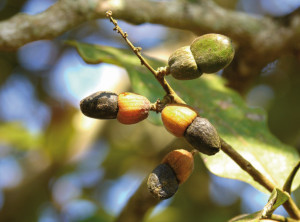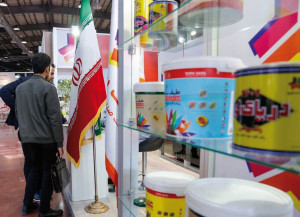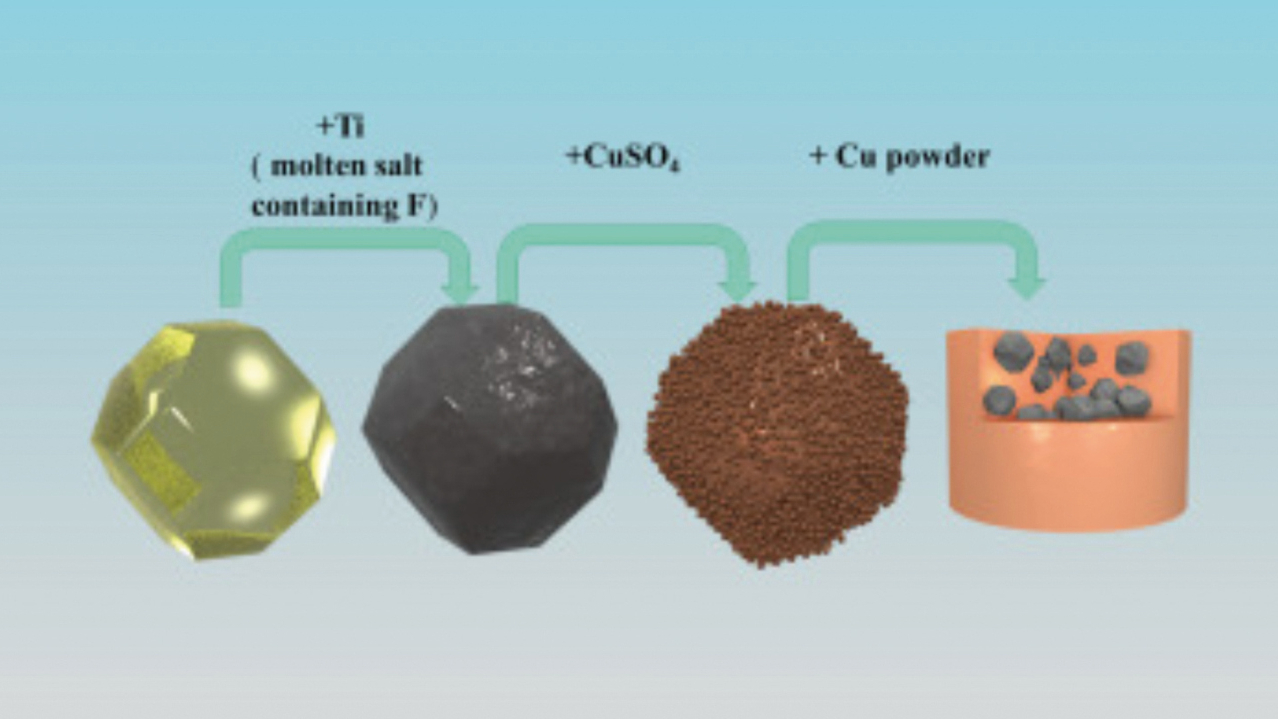The problem of thermal management is a major bottleneck for maintaining and improving the performance of today's ubiquitous high power density electronic devices. Copper-diamond composites have the potential to be used as next-generation heat sinks in advanced electronic devices because man-made diamond, as a metal matrix composite reinforcement, has the highest thermal conductivity (TC) of up to 2200 W/(m K) in nature. In addition, the coefficient of thermal expansion (CTE) of copper-diamond composites can be adjusted to be close to that of semiconductor chip materials (4-6 ppm/K). The copper-diamond composite is stable at ambient temperature and has isotropic thermal conductivity, which does not limit its wide application (Fig. 1).
Unfortunately, the chemical affinity between the copper and the diamond particles is low, so that copper and diamonds hardly bond with each other. The interface between the copper and the diamond particles is very important in the copper-diamond composites and has a bridging function to transfer the heat between the reinforcement and the matrix. Researchers at Chang'an University in Xi'an, China have improved the thermal properties of diamond/Cu composites by TiC coating with molten fluoride-containing salts and electroless plated Cu on diamond particles. The Cu coating coated the TiC/diamond well by electroless plating.
Diamond and Related Materials, 2022, Vol. 129, 109337;
https://doi.org/10.1016/j.diamond.2022.109337
Khaki
 Fig. 2: Fruit of the tree Semecarpus anacardiumTheword "khaki", which is associated with textiles and with the khaki color, comes from Urdu and Persian and means "dust" or "dusty". Khaki has an interesting history. In 1844, the Basel Mission set up a weaving mill in Balmatta, Mangalore, a coastal town in southwest India, on land donated by the collector H. M. Blair, which was run by Christian converts from the so-called lower castes. The fabrics produced were initially of poor quality. The Industrial Commission, which was set up in 1846 to support the industrial activities of the missionaries, sent Johannes Haller, a trained weaving specialist. According to the archives, weaving developed "by leaps and bounds" after his arrival.
Fig. 2: Fruit of the tree Semecarpus anacardiumTheword "khaki", which is associated with textiles and with the khaki color, comes from Urdu and Persian and means "dust" or "dusty". Khaki has an interesting history. In 1844, the Basel Mission set up a weaving mill in Balmatta, Mangalore, a coastal town in southwest India, on land donated by the collector H. M. Blair, which was run by Christian converts from the so-called lower castes. The fabrics produced were initially of poor quality. The Industrial Commission, which was set up in 1846 to support the industrial activities of the missionaries, sent Johannes Haller, a trained weaving specialist. According to the archives, weaving developed "by leaps and bounds" after his arrival.
The German textile engineer and Christian missionary Johannes Haller was also a trained master weaver. Haller invented the new khaki dye from the bark of the Semecarpus tree in the weaving mill of the Basel Mission in Balmatta in 1851. Semecarpus anacardium was called "marking nut" by Europeans because it was used by launderers to mark fabrics and garments before washing, as it gave the fabric a water-insoluble mark. Haller produced this dye from cashew shells. Cashew nuts are grown in large quantities in Goa and South Karnataka. Shortly afterwards, the British adopted the khaki-colored fabric with the melodious name for their uniforms, first in India and then throughout the British Empire. Haller's khaki was and is very popular with the military because of its durability (Fig. 2).
Jaiprakash Raghavaiah's doctoral thesis ("Basel Mission industries in Malabar and South Canara: 1834-1914") and reports from the German Protestant Mission in the archives department of the Karnataka Theological College (KTC), Balmatta, provide further insights into the development of khaki as a textile dye. The khaki color is also produced by electroplating using alloy coating. You can even buy khaki glasses, wristwatches, zippers or cell phone covers online.
https://www.bmarchives.org/items/show/100216873
IPCC 2022 in Tehran
 Fig. 3: The IPCC took place from November 30 to December 3, 2022 in the Iranian capital TehranThe22nd International Paint, Resin, Coating, Composite and Electroplating Industry Exhibition (IPCC 2022) was held in Tehran from November 30 to December 3. During this four-day event, the latest products and services of more than 260 domestic and foreign companies from the paints and coatings industry and related sectors were presented. Companies in the chemical industry, manufacturers of paints, adhesives and resins as well as companies active in the electroplating industry took part in IPCC 2022. The IPCC is considered Iran's most important event in the paints and coatings industry.
Fig. 3: The IPCC took place from November 30 to December 3, 2022 in the Iranian capital TehranThe22nd International Paint, Resin, Coating, Composite and Electroplating Industry Exhibition (IPCC 2022) was held in Tehran from November 30 to December 3. During this four-day event, the latest products and services of more than 260 domestic and foreign companies from the paints and coatings industry and related sectors were presented. Companies in the chemical industry, manufacturers of paints, adhesives and resins as well as companies active in the electroplating industry took part in IPCC 2022. The IPCC is considered Iran's most important event in the paints and coatings industry.
Iran exported 7,291 tons of paints and resins worth almost 26 million dollars in the first eight months of the current Iranian calendar year, recording a year-on-year increase of 17%.
Iraq, Azerbaijan and Afghanistan, Armenia and Turkmenistan were the most important export destinations for Iranian paints and resins in these eight months. Iran also imported 2,858 tons of the aforementioned products worth USD 18.421 million from the United Arab Emirates (UAE), South Korea, China and Germany during this period.
https://www.tehrantimes.com/news/479348/Exports-of-paint-resin-up-17-in-8-months-yr-yr
Alfa Chemistry
Alfa Chemistry, a global contract research organization (CRO) based in Ronkonkoma, New York State, USA, is known as a major supplier in the fields of organic chemistry, materials chemistry and medicinal chemistry. Alfa Chemistry supplies building blocks, research chemicals, reagents, catalysts and reference materials. It offers more than 80,000 products, custom synthesis and analytical services.
The company announced in November 2022 the launch of three types of specialized materials and products, i.e. phosphors, biomedical polymers and electroplating intermediates. Alfa Chemistry makes a comprehensive contribution to the supply of upstream raw materials to the electroplating industry and offers a wide range of intermediates for electroplating, including intermediates for nickel plating, zinc plating, copper plating, tin plating, chrome plating and alloying.
https://www.alfa-chemistry.com/products/material-chemicals-6.htm


